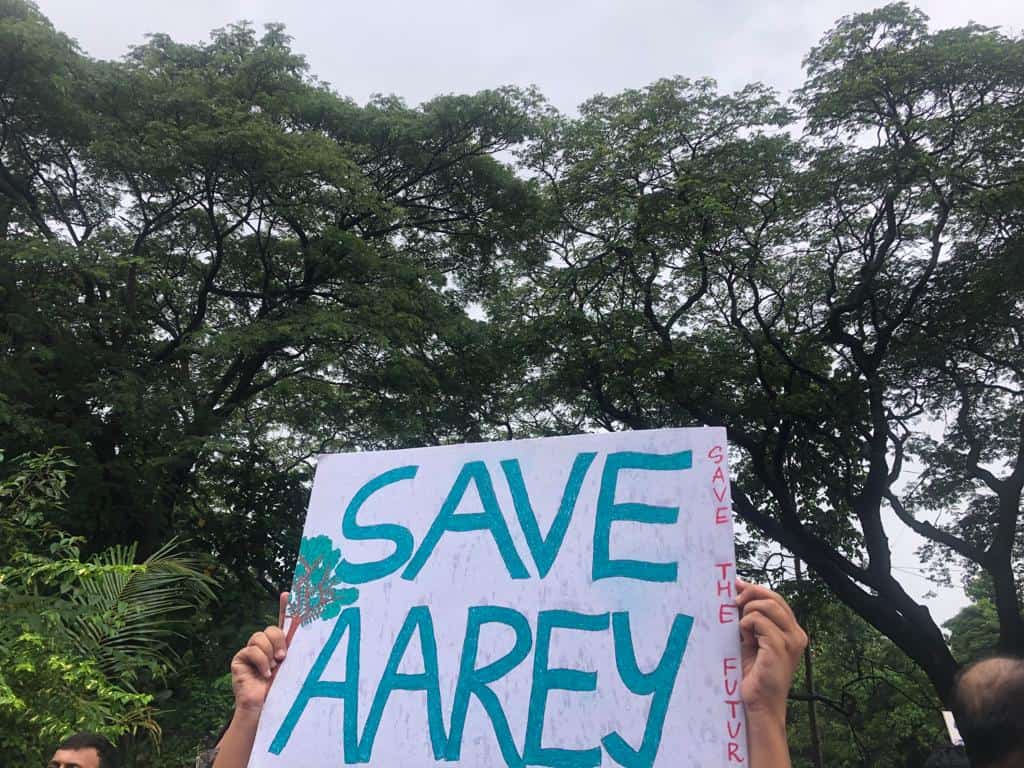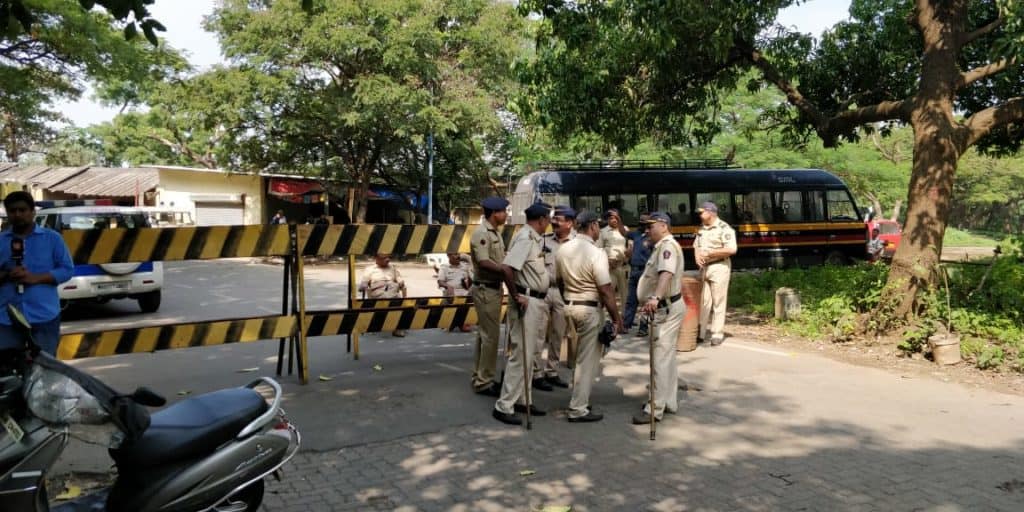On June 30th, the Shiv Sena rebel leader Eknath Shinde became the 20th Chief Minister of Maharashtra, and Bharatiya Janata Party’s Devendra Fadnavis returned to power as his deputy. In their first cabinet meeting, held hours after the oath-taking ceremony, the first decision they took was to shift the construction of the metro car shed for the 33.5 km underground Colaba-Bandra-SEEPZ Metro Project (Line 3) from Kanjurmarg back to the Aarey Milk Colony in Goregaon. Effectively affecting the Aarey forest as a whole.
Backlash followed as environmentalists took to the streets in protest after two-odd years. Commonly known as ‘Aarey forest’, the area is a green strip spread over 13,000 Hectares out of which 33 Hectares would be used for the car shed.
Hashtags such as “Save Aarey”, by those who oppose the car shed, and “CarShedWahiBanega”, by those in favour of it, have been doing rounds on social media ever since the announcement.
While Mumbai’s traffic and commuting woes are presented as the argument in favour of the car shed in the forest, activists and environmentalists caution against pitting commuters’ safety and convenience against the precious and ever-shrinking green lung of the city. Unimaginable pressure on the suburban network and crowded trains and extremely stressful commute for lakhs of Mumbaikars is fast precipitating the issue of the delayed metro line.
Mumbai’s commuting challenges vs Aarey forest as green lung
Along with a picture of one such crowded train, a popular Twitter handle, Roads of Mumbai wrote, “Recently the media is just showing one side (Protestors) in Aarey Metro car shed controversy. Request the media to please visit any local railway station, or bus depots around the Metro 3 Line during peak hours to check what commuters want. It will be a good reality check!”
In 2019-20, a fleet of 225 local trains was used to run 3,031 train services, carrying an average of 85.3 lakh passengers. It is common to see commuters cross railway tracks and climb up to the next platform to save time and avoid crowds. This is dangerous and many lose their lives in doing so; according to the 2021-21 Economic Survey of Maharashtra, 1,455 people died while crossing the railway tracks in 2019. In the same year, a total of 611 people died and 1,406 were injured while travelling on the local trains.
While the protestors largely agree that the city needs an additional mode of transport, they argue that the delays in the completion of Line 3 is not because of them. “We are not against metro, we are against the site for the metro car shed. It is not us who are delaying the project, there are a number of reasons why the work for Line 3 remains incomplete,” said Nishant Bangera, founder of Muse Foundation, a youth-led environmental group.
Line 3 was supposed to be completed by 2021-22, it was then pushed to 2022-23. Addressing the media in April this year, Mumbai Metropolitan Region Development Authority (MMRDA) commissioner and the managing director of the Mumbai Metro Rail Corporation (MMRC) SVR Srinivas said, “Mumbai metro Line 3 will take at least another two to two-and-a-half years to complete as a lot of work remains other than the depot (car shed).”
The depot work can now start as it has been shifted back to Aarey but there are still a lot of other works that are pending, Srinivas told Citizen Matters. “The depot will take about a year’s time to be completed,” he said.
When former Prime Minister Manmohan Singh laid the foundation stone for Metro One in 2006, it was expected to be completed in the next two to three years. However, it was only in 2014 that it was rolled out for public use. The project was delayed due to land issues. Furthermore, problems faced while removing encroachments and religious structures also stalled the construction at several locations.
Politics and protests over Aarey forest
The Shinde-Fadnavis decision is also sending a political message. It was in 2016, under the leadership of Fadnavis, that further construction for the metro project began. The project saw a huge public outcry in its early days when the plan to construct the car shed for Line 3 in Aarey was announced.
In a February 2016 letter to the Centre’s environment ministry, MMRC states that 33 hectares area in Aarey has been approved by the state government for the car depot and in total 62 hectares would be required for other “related activities”. The MMRCL asked the ministry to “delete the said area from Eco-Sensitive Zone”.
In December 2016, the ministry created a buffer zone for Sanjay Gandhi National Park (SGNP) and excluded 165 hectares of Aarey as the “land for the Mumbai Metro Rail Shed of Mumbai Metro Rail Corporation, temple etc.”
Srinivas refuted such a large allocation of Aarey land. “Right now what we have is 29 hectares, we should be able to manage that,” he said. He did not comment on the letter mentioning the requirement of 62 hectares of Aarey land.
When Fadnavis was in power as the Chief Minister, he assured that there would be no commercial exploitation of Aarey under his watch. But environmentalists like D Stalin, whose NGO Vanshakti is also fighting the legal battle to “save” Aarey, aren’t convinced. “If the car shed happens, it will be the end of Aarey. There will be further real estate development in the area,” Stalin said.
Read more: “Aarey is the most abused and exploited land mass in Mumbai”
In 2019, the Brihanmumbai Municipal Corporation (BMC) gave approval to the MMRC to cut 2,185 trees in Aarey and transplant 460 trees to further construction works. What followed was strong public resistance, so much so that even the Sena, who was then in alliance with the BJP and in control of the BMC, extended its support to the protesting citizens.

In October that year, after the Bombay High Court dismissed the petitions challenging the felling of trees in Aarey forest, the MMRC barricaded the area with the help of police and started cutting trees.
This only intensified the agitation and the police took action against the protestors as they jumped over the barricades to reach the car shed spots. Many were arrested and released days later on the orders of the Supreme Court, which also directed the government to maintain the status quo “till the next date of hearing with respect to cutting of trees”. However, Solicitor General Tushar Mehta, appearing for the state government, told the court that “whatever [trees] had to be cut, are cut”, and “nothing further is to be cut”.
When Sena’s alliance with the BJP broke later that year, and its supremo Uddhav Thackeray became the Chief Minister with support from the Congress and the Nationalist Congress Party, the very first decision that he took was to shift the construction of the car shed from Aarey to a 102-acre salt pan land on Kanjurmarg. The recent swift overturn of the previous government’s decision has overtures of political retaliation or tit for tat.

Search for a new land
Shift to Kanjurmarg, an alternative location for the car shed was not easy either. The move became a land ownership dispute between the state and the Centre and the construction at Kanjurmarg was put on hold by the High Court. Up until now, the MMRDA was in the process of looking for alternatives to the Kanjurmarg. Officials were examining locations such as the Bandra Kurla Complex (BKC), South Mumbai, and Pahadi Goregaon (also under litigation), there were even deliberations on constructing multiple mini-car sheds at different locations.
“We are just executing agency. Wherever the government gives us land, we will execute,” Srinivas said. Amidst this hunt for land that would be an alternative to Aarey, the total cost of Line 3 escalated by Rs 10,270 crores in 2021. The original estimate of Line 3 was Rs 23,136 crore. Officials told the press that there the cost mainly increased because of the construction of the tunnel, stations, and the car shed issue.
“Where is the alternative land? BKC is very expensive, and Kanjurmarg and Pahadi Goregaon are under litigation. Right now there is no other land available for it, already 20-25% construction has happened (at Aarey)” Srinivas said. By January this year, a total of Rs 19,967.92 crores were spent on Line 3 and 71.5 per cent of the work was completed.
Disastrous consequences for remaining Aarey forest
Environmentalists have been asserting that Aarey is a cradle of biodiversity and any concretisation would lead to disastrous consequences. Wildlife biologist Anand Pendharkar argues that financial losses cannot just be measured in land areas.
Aarey also works as the catchment area of the city’s Mithi river. “The capacity of flood control is at risk. Grasslands buffer heavy rainfall. If there is construction on such areas, it will lead to an overflow of water which will rush faster into the city area,” he said.
Reports of human-animal conflict have been a frequent occurrence around Aarey even before the work for the car shed began. However, environmentalists see it worsen if any more construction is carried out in the area.
A 2018 survey by SGNP showed the presence of 48 leopards within the park. Another 2015 survey by SGNP suggests that Aarey is one of the dominant leopard habitats and that at any given time there are about four to five adult leopards in the area, including a population that moves between Aarey and SGNP.
The forest is also home to approximately 10,000 Adivasis, who reside in 27 hamlets. A report in People’s Archive of Rural India estimates that about 70 Adivasi families lost their homes to the metro project when it first began in Prajapurpada. The Adivasis are even more worried about losing their livelihood and livestock.
Broken promises
As an environment minister in his father’s cabinet, Aaditya Thackeray declared 812 acres of land within Aarey as reserved forest but it did not include the Line 3 car shed land.
In February this year, he said the ownership of the car shed land would soon be transferred to the forest department but that never happened and MVA collapsed in June.
With no legal protection for the “forest” land, environmentalists are back to ground zero. Like the last time, the protests are carried out every Sunday as most participants are working people and students. “We can only try and get more people involved. We don’t have any other option,” Bangera said.
It’s an elaborative article on Aaray forest with facts and excellently written.
Thanks for sharing the blog.
We are behind time in saving this planet. Every tree is crucial. No purpose in having more and more concrete, if we have to carry oxygen cylinders on our back.